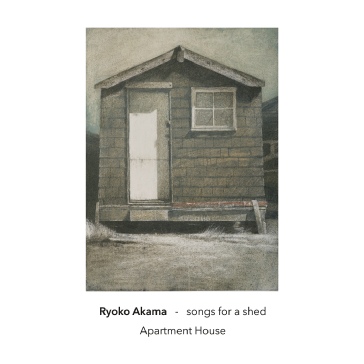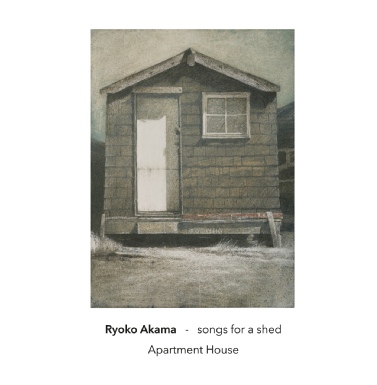Another Timbre TimHarrisonbre

at180 Ryoko Akama - ‘songs for a shed’
A series of pieces for piano and other instruments, commissioned by Philip Thomas and Another Timbre, and played by Apartment House
1. ichi go ich e 9:14 Siwan Rhys (piano) Simon Limbrick (vibraphone) youtube extract
2. melody 10:32 Gavin Morrison (alto flute) Siwan Rhys (piano) Simon Limbrick (marimba) Heather Roche (clarinet) Anton Lukoszeveize (cello) Angharad Davies (violin)
3. 10 days’ etude 6:38 Siwan Rhys (piano)
4. this and that 6:43 Angharad Davies (violin) Gavin Morrison (alto flute) Heather Roche (bass clarinet) Anton Lukoszevieze (cello) Siwan Rhys (piano)
5. proposal eleven 18:21 Anton Lukoszevieze (cello) Heather Roche (bass clarinet) Angharad Davies (violin) Simon Limbrick (vibraphone) Siwan Rhys (piano) Gavin Morrison (alto flute)
6. a shed song 18:09 Siwan Rhys (piano) youtube extract
Cover painting by Maxwell Doig
Ian Power interviews Ryoko Akama
Ian: Why are these pieces together on this CD, and can you give us some insight into the title?
Ryoko: Simon Reynell approached me and asked, “Do you want to write piano works for Philip Thomas”? Simon wanted all of the works to be pitch-based. For me, that is like learning a new technology. You know, I kind of understand it, but not really enough to write or communicate with traditional notation. So the idea was, let’s spend months and months together, Philip and myself. We live quite close by; can we do some sort of, like, learning zone for me to express or execute with the notation-based scores, but still something “alternative”. And then it didn’t happen for a bit, and then the pandemic started, and then suddenly Philip became ill.
And then, during these months and months of not being able to do anything, I got into this project: we have a shed in the garden, and before, every time I wanted to do a bit of DIY, I would ask someone else to help me or do something for me. But then I was like, you know what? Sod it. Don’t apply my ideas to someone else. Just try to do something. So I made a project for myself to be a bit more useful for myself, which was about creating or refurbishing the shed, learning more carpentry skills to do it all by myself. So I spent a lot of time in the shed breaking and making and learning stuff, and sewing and all of these skills that I didn’t think I could do. Again, I couldn’t just be a carpenter. I was still kind of thinking creatively and aesthetically. So I got into this idea of a spatial sort of interaction, very individual. No one was about, I was absolutely locked down, but enjoying myself being part of the space. And it was all about me doing it. So I spent a lot of time in the shed. It’s not completed yet. So that’s in parallel, and that’s where the title came from that I want to make music for being in a shed.
I: Tell me a little bit about your compositional process or writing process. Does it work similarly each time in the sense that you have kind of a map of how it’s going to go? Or is it more free form?
R: Some of the scores are very free form. But I think during the lockdown I was very interested in documentary kind of things. So with ten days’ etude: the first day, this section’s created. The next day, I created another one. There wasn’t much continuity; it was like, okay, I did this yesterday, I need to follow it up. I just did a bit every day for ten days, so it’s called ten days’ etude.
I: So that was an etude for you the composer.
R: Yeah. So overall, it eventually kind of made sense, because I was thinking a lot. But that was my like setup rule, the ten days I’m going to spend a bit of time to continue this composition. So anyway, I think all of the scores for this project came from the fact that I was at home with a piano, because I couldn’t go anywhere. Eventually when I started to work with Siwan Rhys, it was still only on Zoom. So I never met her in person or never spent enough time with her to do something. I mean, for me it wasn’t enough time. For many reasons, I feel quite, not insecure, but I just feel like this is still like a processing thing, because I was just absolutely on my own.
I: What is your relationship to the piano?
R: I always liked sound of pianos, of course depending on who plays. It’s just really nice that it’s there and then anyone can play. I think it’s just a nice thing for kids as well, that you play and something happens. You know? Not like violins or other instruments, where you have to take it out and then you have to spend a bit of time too. But the piano is just there, you open it, and then play and just have a laugh or it sounds great or whatever. I told Siwan Rhys that, can you play as if you’ve just discovered the piano? And don’t try to do too much, like not interesting but sophisticated things.
I: When I looked at the score for ichi go ichi e, it’s a photograph of notecards and envelopes. Is that how it was delivered to the performers?
R: It’s very physical. That’s the only physical one that I did for this project. And this is probably like more “Ryoko” style. There are note cards labeled 1, 2, 3, 4, 5, so that the first equation was, are we supposed to play in order from 1 to 5, or can we have it like whatever you want? So we did a few different versions, because I didn’t want to give an answer to that. So one of them is played from 1, 2, 3, 4, 5. So one played 1, 2, 3, 4, 5, and the other played 1, 2, 3, 4, 5, and then the idea was that you can swap 1 and 1 or 2 and 2. ichi go ichi e is a Japanese phrase meaning when it happens, it happens, and when it goes, it goes.
I: Is there any frustration that your unique scores are not somehow presented with a project like this, that people can’t see them? Is there an ideal way for your work as a whole to be public facing, if you could design it from scratch?
R: I always wonder if or how a score might be performed or translated by other people without knowing who made it. Because I think my problem is quite often that people feel subconsciously, perhaps, that real scores are quiet, and it should be played pp or p. And I kind of have to say that this score doesn’t really say that. You know, just play with confidence. Sometimes on the scores I would hint at that, like play more directly and confidently or something. And if someone takes it as loud as possible, that's up to them. But if people know my music, they think okay, it’s really, really quiet. And occasionally I have to say, no no no no no, it’s fine. Just play it. Play the piece. Because I also change myself, like what I'm into and stuff like that. Let’s say ten days’ etude sounds like it’s by me. But how would it be played by a pianist if the composer wasn't visible? How does that change the entire attitude?
I: Put this project in context. What came before it? What has come or is coming after it for you? And how does it fit or bridge that timeline?
R: I still think this project is in process, in progress. For me, it’s really interesting to work with pitch-based scores. I don’t know if I can say traditional, because it’s not traditional for me. I want to work a bit more with that in the future, with real people in a real space. It would be really nice if I could spend more time with people. And I think that’s what comes next, that I want to see and work with people, because these scores all came from solitude. And a shed song is just an absolute solitude piece. Sometimes it just really doesn’t make sense when you go page by page, but it’s me being alone with the piano. So when I gave it to Siwan, I said I think it needs to have lots of corrections. Let me know where it doesn’t work and when it does, because I’ve never made a piece like this, which is 18, 20 minutes long. Just, you know, musically correct me. And then she was like, it’s fine. Just let’s go for it. It sounds strange, but it’s okay, let’s leave it as it is. She just corrected me with things like, oh, I think you mean F, because you’re putting C here, but you had put E-sharp, and she’s like, what does that mean? Are you being experimental? No, it goes on the F. So apart from little technical things like that, she just said absolutely fine, don’t worry about it. And it was a very strange piece to listen to, cause I kind of, I could feel that I did it by myself. It would be really great if I can just continue working on it. Because most often people say, can you write a text score, which is fine. I love text scores. But it’s not often that someone says, can you write scores, but with pitches. And I’m like, okay, sir. You know? I’m going to try my best.

Ryoko Akama, photo by Anton Lukoszevieze



Envelope #2 ichi go ichi e
Envelope #1 ichi go ichi e